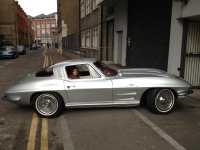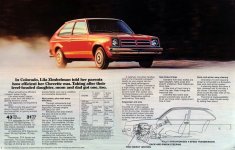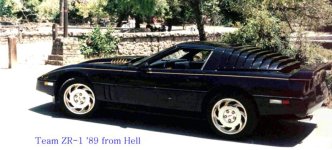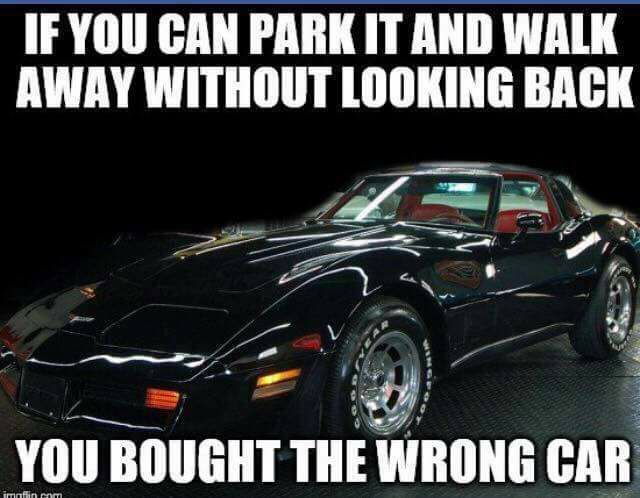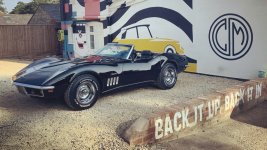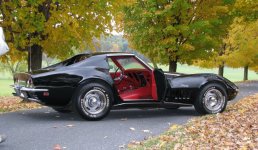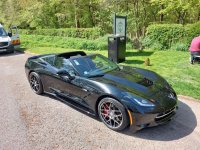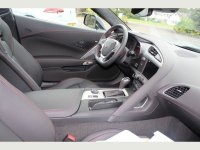Mr. Cricket
Committee Member
I found a fascinating article on the Corvette Forum going into the detail of the origins of how Corvette colours were named over the years. I reached out to the author Greg LaRiviere and asked for his permission to copy it to here in full and in true Corvette brotherhood style he said sure, go ahead so thanks Greg 
Enjoy
What's in a Name?
Ever wonder where the name for the paint color of your Corvette came from?
These weren't just random names picked out a of a hat or named after some GM executive's favorite canine. After years of innocuous names like Tuxedo Black, Ermine White, Arctic Blue, etc. like most manufacturers used at the time, Chevrolet quickly saw the advantage of connecting Corvette and, especially, the all new 1963 Sting Ray to some of the more famous speedways, national and international races that were sweeping the world in popularity. A perfect storm for America's first and only true sports car, itself a formidable contender in many of these very same races. Later, as gas prices inflated, the EPA started strangling internal combustion autos which brought the inevitable drop in horsepower and, as such, the racing craze began to wane, Chevrolet drifted from these high performance related monikers and opted for more generic terms again like "Red", "Blue", "Dark Blue" "Silver", etc. So I'll keep this to the more era specific C2's and C3's when America's muscle car culture ruled, the population was still horsepower crazy, cars were fun and Corvette was the undisputed King of the Hill.
Some are still famous and easily recognizable while a few have become rather obscure over the years. So for those who'd like to know please read on....
1963 saw the introduction of "Daytona Blue" in homage to the now iconic Daytona International Speedway in Daytona Beach, Florida which had opened just 4 years earlier in 1959. Daytona fever was sweeping the nation. American Dan Gurney had recently beat out top flight British driver Stirling Moss for the win at the Daytona Continental (precursor to the Rolex 24 Hours), beach movies, Spring Break (anchorman Chet Huntley described it as a "new phenomenon" at "the most famous beach in the world"). A quick thinking surf/rock band borrowed the name when Ronnie and the Daytonas were singing about, ....what else? Cars! Just a few short years later the Daytona Charger with its distinctive nose cone and 23 inch tall rear stabilizer wing would be the first car to break the 200 mph barrier in NASCAR, Studebaker offered a Daytona nameplate on their Lark platform, even Ferrari would eventually pay homage to the iconic superspeedway when they unveiled the Daytona Spyder. With seating for over 100,000 race fans Daytona International Speedway had proven it could draw fans like no other track in the country, it was a force to be reckoned with and it was here to stay. Daytona was the first race track related name used by Chevrolet for the Corvette color palette but if you read along you'll find it "repurposed" a few years later, which seems odd because there was certainly no shortage of speedway and race track names out there.
"Riverside Red" also made its first appearance in 1963. Named for Riverside International Raceway in Riverside, California just 50 miles east of Los Angeles. Opened in 1957 it was considered a complicated and somewhat dangerous track but also one of the finest courses in the country. This track was used in countless television series, movies and TV commercials. Due to urban sprawl the track's days were numbered and it closed in 1989. It is now the site of a shopping mall. An odd footnote: On opening day, September 22, 1957 a driver was killed, and on the very last day's race, July 1st, 1989 it ended the way it started when another driver lost his life.
"Sebring Silver" was new for 1963 too. Named for America's oldest permanent road racing facility Sebring International Raceway near Sebring, Florida in the south central part of the state. Originally part of Hendricks Army Airfield, a World War II training base for B-17 pilots from 1941 to 1946. Sebring ran its first race on New Year's Eve 1950. Much of the track still uses the original concrete poured in 1941 making the track intentionally difficult on both drivers and their cars. The grueling 12 Hours of Sebring is the yardstick used to measure those on their way to LeMans.
The new Sting Ray for 1964 used the same raceway names as 1963.
1965 added "Glen Green" to list of popular colors, borrowed from Watkins Glen International near Watkins Glen, New York. WGI was home to the Formula One United States Grand Prix. The World Sportscar Championship, Trans-Am, Can-Am, IndyCar and NASCAR have all run there as well. Opened in 1956 the track was wildly successful. 1973 saw the Summer Jam rock festival at WGI, headliners were The Allman Brothers, The Grateful Dead and The Band. Attended by more than 600,000 fans which was enough to get it into the Guinness Book of World Records as the largest attendance ever at a music festival. Due to some poor management the track filed for bankruptcy and closed in 1981. Two years later the track was purchased by Corning, fully renovated, reopened and is still going strong.
1965 also saw the addition the very popular "Nassau Blue" as a tip of the hat to Nassau Oakes Field in Nassau, Bahamas. Laid out on the runways and roads of the former Oakes Field Airport and opened in 1957. The track had a great run and, with location names like "Sassoon Straight", "Ecky's Twist" and the unforgettable "Blackbeard's Bend" who wouldn't want to race there? Stirling Moss took the Nassau Trophy in the track's second year. The Americans made a big noise in 1963 when Ford and Chevrolet showed up, with Chevrolet sweeping all of the major trophies that year. 1965 was also the year that The Beatles filmed portions of their second movie HELP! in the sunny Bahamas. Unfortunately political change as well as island economics took their toll and the Nassau course was closed permanently in 1966.
And, speaking of 1966, that was the year Chevrolet introduced "Laguna Blue" in tribute to Laguna Seca Raceway located in Monterey County on California's central coast. You will find the name Laguna recycled at a later date as well. Opened in November 1957 Laguna Seca (Spanish for dry lagoon), the course was built around the site of a dried lake bed and formerly U.S. Army Fort Ord's artillery range. Renowned for names like Andretti and Unser, it is most famous (or infamous) for its harrowing " Corkscrew". There is nothing like it on any other track anywhere in the world. Between the entrance and exit of turn 8 the track drops almost 60 feet in less than 450 feet of track. This is the equivalent of a 5 1/2 story drop. And if that's not enough to clamp your sphincter, from turn 8 to turn 9 the track drops an additional 109 feet ....or just over 10 full stories. I'm happy to report that as of this writing Laguna Seca is still going strong.
'66 also gave us "Mosport Green" in tribute to Mosport Park which our friends to the north opened in 1961 about 50 miles east of Toronto, Ontario Canada. Stirling Moss showed up again and won the Player's 200 event in that first year (there's even a track corner named for him). Mosport hosted the Canadian Grand Prix which proved to be wildly successful among race fans. The track boasts a world class "Driver Development Centre" and has hosted every name associated with the sport including Andretti, Unser, Ongias, Jones, Foyt, McLaren, Fittipaldi, Villeneuve and of course Jackie Stewart. 2012 brought a name change of Canadian Tire Motorsport Park and the track continues to thrive.
With the dawn of 1967 four new "race related" offerings showed up, beginning with "Lynndale Blue" , who's namesake was the beautiful but short-lived Lynndale Farms Raceway situated just 20 miles west of Milwaukee, Wisconsin. Agreed by all to have been a great track and a great idea, it was the brain child of real estate broker/developer and sports car enthusiast, Jerry Hirsch. Opened in 1963 the course was actually named for Hirsch's teen daughter Lynn. The 2.5 mile track hosted SCCA and USAC events. But sometimes the best laid plans of mice and men... Even the presence of the ubiquitous Stirling Moss on opening day couldn't stave off the inevitable. Hirsch was plagued by a series of misfortunes from bad weather (many events were rained out) to irate neighbors who simply hated all, the noise. Sadly just four short years later, in 1967, Hirsch threw in the towel and closed the track. He sold his sports cars and never looked back. Today the site is unrecognizable with its sprawling subdivisions and houses with nicely mowed lawns. Lost to the sands of time forever. But I'd like to think that when Ms. Hirsch happens to pass a rare Lynndale Blue Corvette on the road, she recognizes it, feels a little pride and she shows just the ghost of a smile as she passes by. Quite the legacy.
Continues next page due to page size limits
Enjoy
What's in a Name?
Ever wonder where the name for the paint color of your Corvette came from?
These weren't just random names picked out a of a hat or named after some GM executive's favorite canine. After years of innocuous names like Tuxedo Black, Ermine White, Arctic Blue, etc. like most manufacturers used at the time, Chevrolet quickly saw the advantage of connecting Corvette and, especially, the all new 1963 Sting Ray to some of the more famous speedways, national and international races that were sweeping the world in popularity. A perfect storm for America's first and only true sports car, itself a formidable contender in many of these very same races. Later, as gas prices inflated, the EPA started strangling internal combustion autos which brought the inevitable drop in horsepower and, as such, the racing craze began to wane, Chevrolet drifted from these high performance related monikers and opted for more generic terms again like "Red", "Blue", "Dark Blue" "Silver", etc. So I'll keep this to the more era specific C2's and C3's when America's muscle car culture ruled, the population was still horsepower crazy, cars were fun and Corvette was the undisputed King of the Hill.
Some are still famous and easily recognizable while a few have become rather obscure over the years. So for those who'd like to know please read on....
1963 saw the introduction of "Daytona Blue" in homage to the now iconic Daytona International Speedway in Daytona Beach, Florida which had opened just 4 years earlier in 1959. Daytona fever was sweeping the nation. American Dan Gurney had recently beat out top flight British driver Stirling Moss for the win at the Daytona Continental (precursor to the Rolex 24 Hours), beach movies, Spring Break (anchorman Chet Huntley described it as a "new phenomenon" at "the most famous beach in the world"). A quick thinking surf/rock band borrowed the name when Ronnie and the Daytonas were singing about, ....what else? Cars! Just a few short years later the Daytona Charger with its distinctive nose cone and 23 inch tall rear stabilizer wing would be the first car to break the 200 mph barrier in NASCAR, Studebaker offered a Daytona nameplate on their Lark platform, even Ferrari would eventually pay homage to the iconic superspeedway when they unveiled the Daytona Spyder. With seating for over 100,000 race fans Daytona International Speedway had proven it could draw fans like no other track in the country, it was a force to be reckoned with and it was here to stay. Daytona was the first race track related name used by Chevrolet for the Corvette color palette but if you read along you'll find it "repurposed" a few years later, which seems odd because there was certainly no shortage of speedway and race track names out there.
"Riverside Red" also made its first appearance in 1963. Named for Riverside International Raceway in Riverside, California just 50 miles east of Los Angeles. Opened in 1957 it was considered a complicated and somewhat dangerous track but also one of the finest courses in the country. This track was used in countless television series, movies and TV commercials. Due to urban sprawl the track's days were numbered and it closed in 1989. It is now the site of a shopping mall. An odd footnote: On opening day, September 22, 1957 a driver was killed, and on the very last day's race, July 1st, 1989 it ended the way it started when another driver lost his life.
"Sebring Silver" was new for 1963 too. Named for America's oldest permanent road racing facility Sebring International Raceway near Sebring, Florida in the south central part of the state. Originally part of Hendricks Army Airfield, a World War II training base for B-17 pilots from 1941 to 1946. Sebring ran its first race on New Year's Eve 1950. Much of the track still uses the original concrete poured in 1941 making the track intentionally difficult on both drivers and their cars. The grueling 12 Hours of Sebring is the yardstick used to measure those on their way to LeMans.
The new Sting Ray for 1964 used the same raceway names as 1963.
1965 added "Glen Green" to list of popular colors, borrowed from Watkins Glen International near Watkins Glen, New York. WGI was home to the Formula One United States Grand Prix. The World Sportscar Championship, Trans-Am, Can-Am, IndyCar and NASCAR have all run there as well. Opened in 1956 the track was wildly successful. 1973 saw the Summer Jam rock festival at WGI, headliners were The Allman Brothers, The Grateful Dead and The Band. Attended by more than 600,000 fans which was enough to get it into the Guinness Book of World Records as the largest attendance ever at a music festival. Due to some poor management the track filed for bankruptcy and closed in 1981. Two years later the track was purchased by Corning, fully renovated, reopened and is still going strong.
1965 also saw the addition the very popular "Nassau Blue" as a tip of the hat to Nassau Oakes Field in Nassau, Bahamas. Laid out on the runways and roads of the former Oakes Field Airport and opened in 1957. The track had a great run and, with location names like "Sassoon Straight", "Ecky's Twist" and the unforgettable "Blackbeard's Bend" who wouldn't want to race there? Stirling Moss took the Nassau Trophy in the track's second year. The Americans made a big noise in 1963 when Ford and Chevrolet showed up, with Chevrolet sweeping all of the major trophies that year. 1965 was also the year that The Beatles filmed portions of their second movie HELP! in the sunny Bahamas. Unfortunately political change as well as island economics took their toll and the Nassau course was closed permanently in 1966.
And, speaking of 1966, that was the year Chevrolet introduced "Laguna Blue" in tribute to Laguna Seca Raceway located in Monterey County on California's central coast. You will find the name Laguna recycled at a later date as well. Opened in November 1957 Laguna Seca (Spanish for dry lagoon), the course was built around the site of a dried lake bed and formerly U.S. Army Fort Ord's artillery range. Renowned for names like Andretti and Unser, it is most famous (or infamous) for its harrowing " Corkscrew". There is nothing like it on any other track anywhere in the world. Between the entrance and exit of turn 8 the track drops almost 60 feet in less than 450 feet of track. This is the equivalent of a 5 1/2 story drop. And if that's not enough to clamp your sphincter, from turn 8 to turn 9 the track drops an additional 109 feet ....or just over 10 full stories. I'm happy to report that as of this writing Laguna Seca is still going strong.
'66 also gave us "Mosport Green" in tribute to Mosport Park which our friends to the north opened in 1961 about 50 miles east of Toronto, Ontario Canada. Stirling Moss showed up again and won the Player's 200 event in that first year (there's even a track corner named for him). Mosport hosted the Canadian Grand Prix which proved to be wildly successful among race fans. The track boasts a world class "Driver Development Centre" and has hosted every name associated with the sport including Andretti, Unser, Ongias, Jones, Foyt, McLaren, Fittipaldi, Villeneuve and of course Jackie Stewart. 2012 brought a name change of Canadian Tire Motorsport Park and the track continues to thrive.
With the dawn of 1967 four new "race related" offerings showed up, beginning with "Lynndale Blue" , who's namesake was the beautiful but short-lived Lynndale Farms Raceway situated just 20 miles west of Milwaukee, Wisconsin. Agreed by all to have been a great track and a great idea, it was the brain child of real estate broker/developer and sports car enthusiast, Jerry Hirsch. Opened in 1963 the course was actually named for Hirsch's teen daughter Lynn. The 2.5 mile track hosted SCCA and USAC events. But sometimes the best laid plans of mice and men... Even the presence of the ubiquitous Stirling Moss on opening day couldn't stave off the inevitable. Hirsch was plagued by a series of misfortunes from bad weather (many events were rained out) to irate neighbors who simply hated all, the noise. Sadly just four short years later, in 1967, Hirsch threw in the towel and closed the track. He sold his sports cars and never looked back. Today the site is unrecognizable with its sprawling subdivisions and houses with nicely mowed lawns. Lost to the sands of time forever. But I'd like to think that when Ms. Hirsch happens to pass a rare Lynndale Blue Corvette on the road, she recognizes it, feels a little pride and she shows just the ghost of a smile as she passes by. Quite the legacy.
Continues next page due to page size limits

